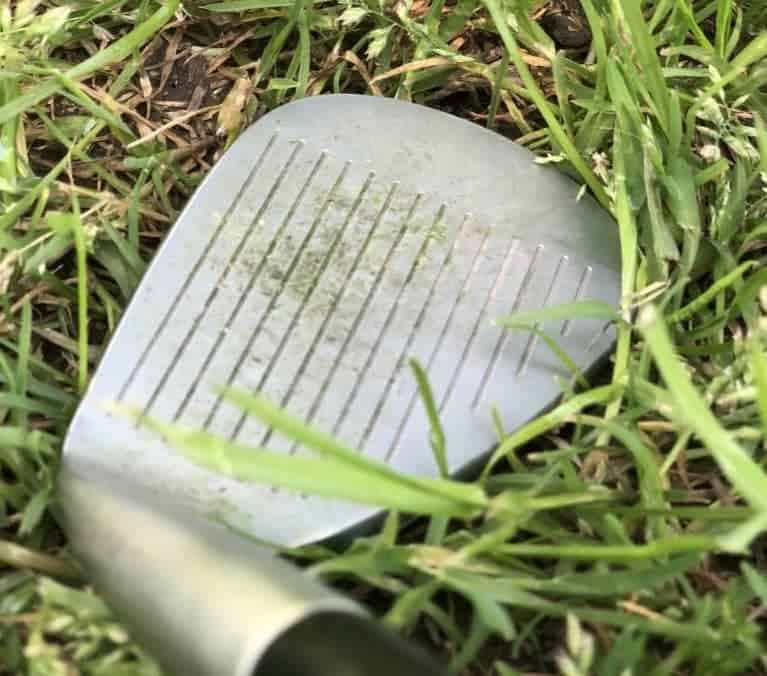
I’m going to be brutally honest with you, I was completely wrong about why do golf club have grooves until I recently looked into it. So sit back and prepare to be amazed…well, maybe not amazed but if you didn’t know the purpose of the grooves just keep reading this post because you might be surprised.
Essentially, the reasons why golf clubs have grooves on the face is to allow water and debris from the ball and your lie as a place to go. If you were to hit a ball that was wet from the rain, at the moment of compression the water and debris would transfer from the ball to the club face and through the grooves. Assuming the grooves are clean that is.
Why Do Golf Clubs Not Have Grooves
A common misconception about golf club grooves is they are meant to give the ball spin. This was my assumption until I did some digging around and discovered a guy by the name of Ralph Maltby. Ralph performed an experiment to debunk this by making clubs without grooves and playing with them.
The conclusions of his experiment proved that you could still get spin on the ball even without grooves on the club face. The grooves were simply there for giving the player the best chance to make contact with the ball in less optimal conditions. Less optimal conditions would be rain, rough, and or a dirty ball.
This makes a lot of sense
When I read this it really made sense to me, the grooves in the club act similar to the tread on tires. When you drive your car during the summer months and you have low tread or sometimes completely bald tires. Even with the tires in bad condition, you can still drive the car and feel safe doing so. But these are dry conditions similar to Ralph Maltby experiment.
Now if you drive that same car with bald tires on a rainy day well that’s a different story. Control of your car becomes extremely difficult and dangerous, hence the reason for tread. Same goes with the grooves in the club face, I can imagine that the control of the ball would be much more difficult.
Should you clean your golf club grooves?
Before I discovered this information about the grooves I would say yes. But now that I know the grooves play a very little role in ball spin I would say “that depends”. I say that because if the conditions are optimal and your lie is beautiful then the grooves don’t matter. Now if the golf club head has a bunch of dirt in the grooves and you can see the dirt protruding out from the grooves than yes, clean the grooves. But if they have a little bit of dirt that’s sitting below the tread line then I would say you are probably fine.
Those were optimal conditions though, how often do you get optimal conditions on a public golf course? I would say not very often. So for less than optimal conditions and lies, I would recommend cleaning the grooves of your clubs.
Controlling the golf ball
Referring back to Ralph Maltby playing without grooves, this would also apply to controlling the golf ball as well. You would be able to give your ball side spin in either direction without grooves on the clubface. This is obvious to me because the grooves are horizontal which wouldn’t have an effect on the ball anyways.
I can totally imagine the golf ball flying in the wrong direction if you didn’t have grooves in the club face. Any debris that was trapped between the ball and the club face could alter the flight and where it ultimately ends up.
Compression on a smooth face vs. grooved face
If we refer back to the good tread on the tires analogy. Imagin the tire reaching the point where it starts going through the water, it gives the water a path to travel. The path the water travels on is the pattern of the tread. If there was no tread then the car would probably skip on the water. My point is, the water needs a place to go when the car drives through water.
If a wet golf ball compresses against a clean club face with grooves, the water has a place to go. Even if it’s the tiniest amount of water, it still needs a place to go or the ball probably won’t compress properly. You won’t hit your target at the very least.
Should you sharpen your grooves?
Sharpening your grooves doesn’t make sense to me, the only reason one would sharpen their grooves is if they thought the grooves made ball spin better. But the grooves don’t make the ball spin so I would say no. On the other hand, you could sharpen your grooves if you had a small dent or blemish near the grooves. I could see this being a good reason but I don’t think it would help with better water transfer or catch debris any better than if they weren’t sharpened.
Why are some wedge grooves deeper and larger than others?
The only reason that comes to mind is marketing more backspin to customers. The only reason for grooves to be deeper and wider is to let more water and dirt into the grooves. But I would think that there would reach a point in the width of the groove that would make the golf ball impossible to control. If the grooves were too deep than so much more dirt would eventually settle over time. If you didn’t clean the grooves it would probably be extremely difficult to remove.
Talking about cleaning grooves, I would highly suggest investing in a tool that gets in the nooks and cranny of the club grooves. You can use tees to clean the groove but sometimes tees just don’t cut it, you need something sharper and firmer.
How many grooves are on each club?
I took a look at my Mizuno MP-4 wedges and I counted 14 grooves. I also counted the grooves on my MP-64 irons and they ranged from 10 grooves to 12 grooves. The surface area is greater on the wedges so it makes sense to have more grooves on them.
Micro-grooves
New wedges have these small grooves around the entire face of the club. It almost resembles a giant thumbprint on the face of your club. I’m assuming these are for better grip on the ball but this shouldn’t be the case for the reasons stated above.
“U” grooves v.s. “V” grooves
In 2010 the USGA put into effect new groove rules, this essentially stated that sharp-edged “U” grooves would not be allowed on tour. Instead, “V” grooves are the only type of groove allowed on any club of 25 degrees or more.
I actually like this from a practical standpoint, if you think about cleaning out the grooves of a “V” shaped club v.s. a “U” shaped club, which would be easier? I would say the “V” shape because what do most people clean the face of their clubs with? A tee, that is “V” shaped at the very point. The grooves are not so deep that it would fit the tee just perfect. I don’t think tees are sharp enough to clean the club grooves completely. But it does make sense, to me at least.
As for performance, the pros on tour are still getting amazing spin on the ball with their wedges. So why did they change the rules?
This is interesting
Apparently, they changed the rules because whenever the pros were hitting from the “rough” they were still able to get an insane amount of spin on the ball. The “U” shaped grooves in combination with sharp edges made it possible for the player to have better control of the ball while in the rough.
This basically contradicts everything I was saying earlier in this post. What the heck is going on here? According to Dick Rugge, USGA Senior Technical Director “The new grooves will have little effect on shots from the fairway or off the tee” Rugge said in a release explaining the new rule. “If you were able to spin a shot from the fairway with the old grooves, you will be able to do it with new grooves as well. The new grooves primarily affect shots from the rough to the green by reducing spin. Most golfers don’t hit greens from the rough very often”
The last part of this quote from Dick Rugge made me laugh, it’s so true too. What are the odds are of your “everyday golfer” hitting the greens from the rough, probably not very high. So trying to get spin on the ball is probably out of the question especially from the rough.
My thoughts on the grooves
I’ve been playing golf my entire life and my best score to date is 80 on 18 holes. I have never seen my ball spin back on the greens in all the playing conditions that I have played. Certainly, I have tried to get backspin but this generally leads to poor golf shots for me.
I understand making it so the pros on tour use “V” shaped grooves because it may give them an edge.
But if you thought it would benefit the everyday golfer than why would you take that away? I feel like the everyday golfer could use that kind of help out of the rough. Even if the odds of him or her hitting the green are low. I can think of a bunch of reasons why they don’t want the everyday golfer to use these clubs.
It’s not like you can’t buy the clubs off of eBay or even find them on Craigslist. Should you use them though, that is the question? Well, if you have no plans to go pro in the future or ever compete in amateur events than I would say who cares. I’m sure it will save a couple strokes over the long haul and who knows, it could add a couple of strokes too.
This post turned into why do golf clubs have grooves to why did the USGA change the rules for grooves on wedges. Hopefully, it still made for an interesting read.


